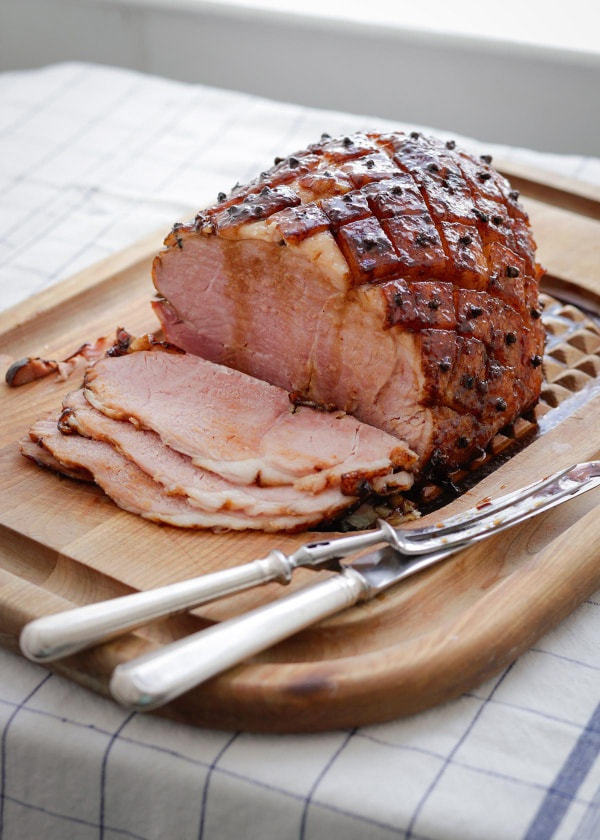Gammon Joints
How To Cook
Traditional Boiling and Baking – Cover your gammon joint with water in a large pan and simmer for 45 mins per kg of meat (if you want to make a stock, add bay leaves etc to the water).
Take the joint out of the water and remove the skin which should easily come away, then score the fat (if you want a traditional looking gammon/ham, score in diamonds and place a few cloves dotted across the gammon). Cover the joint in a glaze. We suggest making a glaze using 2 tablespoons of honey and 2 teaspoons of hot English mustard mixed together. Another easy glaze is to use a ready made marmalade. Put the joint in a preheated oven at 210 degrees Celsius for 15 minutes to crisp the glaze. Enjoy your succulent Christmas gammon hot or cooled down for sandwiches
Take the joint out of the water and remove the skin which should easily come away, then score the fat (if you want a traditional looking gammon/ham, score in diamonds and place a few cloves dotted across the gammon). Cover the joint in a glaze. We suggest making a glaze using 2 tablespoons of honey and 2 teaspoons of hot English mustard mixed together. Another easy glaze is to use a ready made marmalade. Put the joint in a preheated oven at 210 degrees Celsius for 15 minutes to crisp the glaze. Enjoy your succulent Christmas gammon hot or cooled down for sandwiches
Why Not Try....
Nigella Lawson's Slow Cooked Black Treacle Ham
Serves 10-12 (with leftovers)
Method
Ingredients
For the Joint
Serves 10-12 (with leftovers)
Method
- Preheat the oven to 250°C/230°C Fan/gas mark 9/450ºF, and let your gammon come to room temperature.
- Line a large roasting tin with a layer of foil, and then sit a wire rack on top of this foil. Tear off a large piece of foil (big enough to wrap around the ham) and place this over the rack on the roasting tin. Tear off a second, large piece of foil and place on top, but in the opposite way to the first, so you have 4 corners of foil ready to wrap your ham in. Sit the gammon on the foil and then pour the black treacle over it, straight onto the rind, letting it run down both sides. Don’t worry too much about spreading it over the ham, as once it’s in the heat of the oven, it will coat the ham well enough.
- Now lift up the sides and ends of the first layer of foil and make a seal at the top, leaving some room around the gammon, then seal the ends. Then take up the other piece of foil and do the same: you are trying to create a good seal around the gammon, so pinch together any open gaps that remain. Finally, tear off another piece of foil and put over the top of the whole parcel, making sure it’s well sealed.
- Put carefully into the oven and let it cook for 30 minutes, then turn the oven down to 100°C/80°C Fan/gas mark ¼/200°F and leave for a further 12–24 hours.
- The following day, take the gammon out of the oven and open up the foil seal. It will have made some liquid, which you can reserve to moisten the carved meat later. Carefully lift the gammon out onto a board, snip and remove the string, and peel off the rind to leave a good layer of fat.
- Increase the oven temperature to 200°C/180°C Fan/gas mark 6/400ºF. Using a sharp knife, cut a diamond pattern in the fat layer, drawing lines one way and then the opposite way, about 2cm/¾-inch apart.
- Stud the centre of each diamond with a clove, then mix together the black treacle, demerara sugar and Dijon mustard in a bowl and spread over the fat on the ham. It will dribble off a bit, so just spoon it back over the gammon before putting back in the oven for 20 minutes, by which time the glaze will be burnished and blistered in the heat. Remove from the oven, and transfer to a board. Let it rest for 10–20minutes before carving into thin slices.
Ingredients
For the Joint
- 4 kilograms Pacdon Park Gammon Joint
- 150 grams black treacle
- 1 tablespoon whole cloves
- 4 tablespoons black treacle
- 4 tablespoons demerara sugar
- 1 tablespoon Dijon mustar



